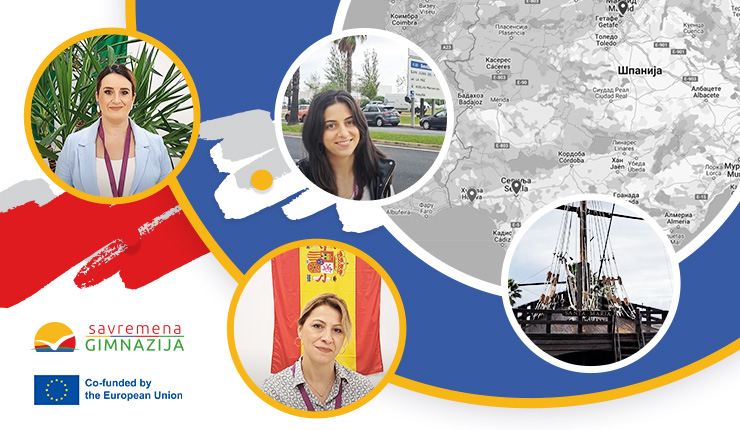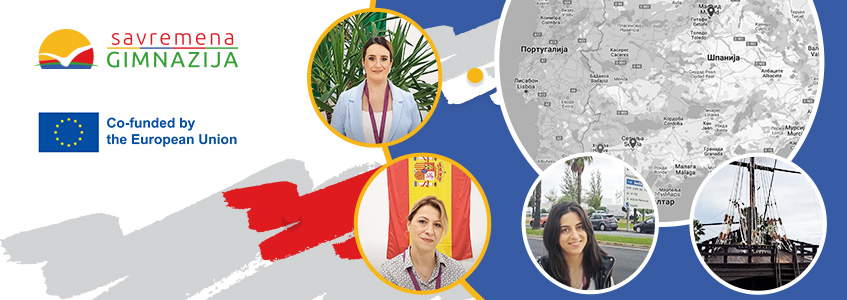
As part of the Erasmus+ project "Flipped Classroom Methodology," English language teacher Olivera Marjanović, geography teacher Ivan Matejić, and Serbian language and literature teacher Marija Pilčević Tomašević attended the "Flipped Classroom" course organised by the educational centre "Inercia Digital" (Spain).
They shared the knowledge and experiences gained during the course with their colleagues at Savremena Gimnazija, as well as with colleagues from other schools in Serbia, by delivering an online lecture organised by the Institute for Contemporary Education.
During and after attending the course, the teachers planned and then carried out an interdisciplinary project (Serbian language and literature, English language, Spanish language, Geography, and Computer Science) with their students, applying the acquired and expanded knowledge of the Flipped Classroom method. The project was based on the Flipped Classroom principle but combined with other related teaching methods.

Twenty students from four classes (II-2, II-3, III-5, and III-6) participated in the project. The students successfully completed all activities and were assessed in all mentioned subjects.
Project Description
The condition for selecting students to participate in the project was that they were attending Spanish language classes. Five students from each class were chosen to form a group. During their stay in Spain, the teachers prepared video recordings describing the project and provided an audio-visual introduction to what the students could expect. The students were initially presented with the video material.
- Vreme je za početak putovanja!
- Warm greetings from sunny Spain!
- Put u potpuno nepoznato…
- Un punto en el Mundo…
Within each subject, the tasks assigned to the students were as follows:
- Geography: Itinerary, planning, Google Maps;
- Serbian language and literature: Itinerary (text), texts about locations;
- English language: Itinerary (text), texts about locations;
- Spanish language: Itinerary (text), texts about locations;
- Computer Science: Budget, calculations, research.
Evaluation and grading were based on established scoring scales and criteria, which are available on the subject links provided to the students.
Certain elements of the project were predetermined:
- Three locations were defined: the cities of Madrid, Seville, and Huelva, with a specific number of localities in each (four each);
- The budget was predetermined, with a total value of 1,500 euros per team member (7,500 euros in total). The students had to plan the trip and all its parts (plane tickets, accommodation, food, transportation, tickets, fees, etc.) based on the allocated budget.
- The duration of the trip had to be between five and eight days.
- The texts about the locations had to be between 150 and 200 words long.
Other elements of the project were flexible and subject to students' assessments and decisions:
- Selection of localities within the cities (four each, 12 in total);
- Choice of means of travel, accommodation, and all aspects related to the stay and transportation;
- Selection of photos and content for the texts about the locations;
- Marking on Google Maps (changing the so-called pins);
- Individual expenses (additional food, visits, outings, gifts, etc.) – it was not obligatory to include them in the budget presentation.
There were also bonus tasks for each subject. They were not mandatory but could earn the students additional points. For English, Spanish, and Serbian language and literature, the students had to answer a question based on the video and thus earn three additional points for their team. In Geography, based on the video, they had to identify the location where the geography teacher was and earn extra points.
Final Project Outcome
The project was considered successfully completed if the teams submitted:
- Google Maps with locations;
- Itinerary (travel plan);
- Budget;
- Sources and literature used.
Each text about the locations had to be the result of collaborative research work, written in their own words using recommended available literature and sources. The writing style of the texts should be encyclopedic and scientific, without excessive use of tourist phrases. The aim of the texts was to provide basic information rather than attract visitors.
Both students and teachers enjoyed carrying out this project. They are ready for a new modern and truly different adventure!

















